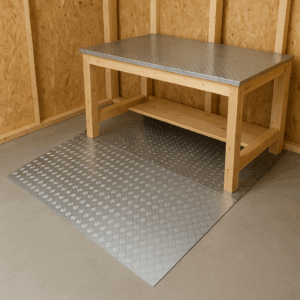
Everyone wants their DIY project to last. Whether it’s a home workshop floor, a shed ramp, or even a new workbench, no one wants to fix or rebuild something just a few months after finishing it. That’s why picking the right materials from the start makes a huge difference. A strong project isn’t just about how it’s built—it’s about what it’s built with.
Cheap materials might seem like a shortcut, but they often lead to problems down the road. Things break, wear out, or fall apart quicker than expected. That’s where smarter choices come in—materials that are known for durability, grip, and holding up under pressure.
Why Strength Matters More Than You Think
When a surface gets used a lot—whether it’s stepped on, rolled over, or worked on—weak materials don’t stand a chance. They bend, dent, or wear out fast. That’s not just annoying, it can also be unsafe. Think about slipping on a wet wooden ramp or cracking a thin surface that wasn’t meant to hold weight. Now you’re not just wasting time and money—you’re risking injury too.
For areas that deal with pressure, heavy use, or changing weather, the material you use needs to be strong and dependable. That means something that can handle weight, resist dents, and stay grippy even when wet. That’s where chequer plate comes in.
What Makes 5-Bar Pattern Aluminium Chequer Plate So Useful?
Aluminium chequer plate (also called tread plate or checker plate) has a raised pattern—usually five bars—that gives extra grip. This makes it perfect for surfaces where slipping might be a problem, like ramps, steps, or garage floors. But the grip isn’t the only reason people use it.
Aluminium is naturally rust-resistant, so it doesn’t corrode or flake over time, even in wet or dirty places. It’s also lightweight, which makes it easier to install compared to heavier metals. And even though it’s light, it’s still tough enough to take hits without bending easily.
For anyone starting a new DIY project, it helps to look through detailed specs and examples. You can find plenty of useful 5-bar pattern aluminium checker plate options online, including sheets that are pre-cut or can be made to size. Choosing the right plate early on saves time, effort, and future repairs.
What You Build On Really Matters
No one ever says, “I wish I used weaker materials.” A project that looks good but can’t handle pressure won’t last. Whether you’re covering a workshop floor or building a ramp to your shed, the base layer is what takes the most beating.
Using wood might be cheaper up front, but if it rots or gets damaged by water, you’ll be replacing it before you know it. Chequer plate doesn’t have that problem. It’s used in trucks, factories, and building sites for a reason—it doesn’t give up easily.
Also, keep in mind how easy it is to clean. Dirt, oil, and mud don’t soak into aluminium the way they do with other materials. A quick wipe or hose-down is often all it takes to make it look fresh again. That means less cleaning, less stress, and a workspace that stays safe.
Projects That Benefit Most from Chequer Plate
Some DIY jobs don’t need anything fancy. But when you want a clean, strong, and long-lasting result, using better materials pays off.
Here are a few examples of where chequer plate really helps:
- Shed floors or garage ramps — especially if they get wet or need to support heavy tools
- Workbench surfaces — where tools get dropped, parts get dragged, and durability matters
- Storage areas or van interiors — where keeping things stable and easy to clean is key
- Step treads or small stairs — extra grip helps prevent slips, especially outside
These aren’t just “nice to have” upgrades. They’re the kind of changes that make life easier, safer, and way less frustrating later on.
The Long-Term Payoff
It’s easy to focus only on the cost at the beginning. But think about what happens over time. If you have to repair, patch, or totally replace your build every year, you’re actually spending more in the long run. And you’re using up more time too.
Solid materials reduce that risk. Aluminium chequer plate doesn’t just hold up—it stays looking good even after lots of use. That’s especially helpful in home workshops or shared spaces where things need to be both strong and tidy.
Also, when a project is built to last, it gives you more confidence to use it the way you want. You’re not tiptoeing around weak spots or crossing your fingers that the floor doesn’t give out. It just works.
What to Think About Before Starting
Before beginning any DIY project, ask a few questions:
- Will this area get wet, muddy, or dirty often?
- Does it need to support heavy weight or equipment?
- How often will it be used?
- Is it a place where safety is important, like a step or ramp?
- Do you want to spend time maintaining it or not?
If the answer to any of those points is “yes,” using better materials is probably worth it. Chequer plate answers a lot of those concerns in one go.
Build It Once, Then Forget About It
The best DIY jobs are the ones you don’t have to keep thinking about. They don’t break. They don’t slip. They don’t need patching up every few months. That only happens when smart decisions get made from the start—like choosing the right materials.
Whether it’s aluminium chequer plate or something else that fits the job, always pick materials that will hold up, stay safe, and make your life easier—not harder.
Do it once. Do it right. And enjoy the project for years to come.
